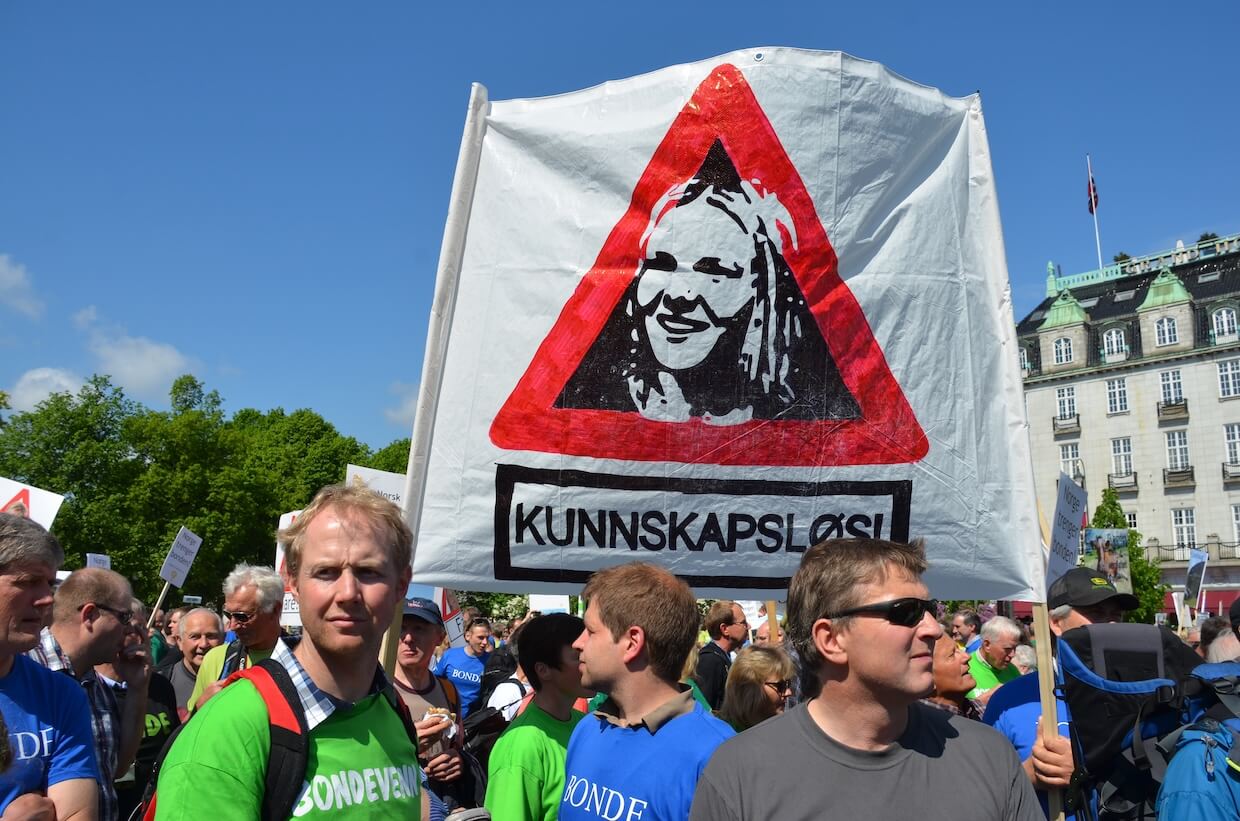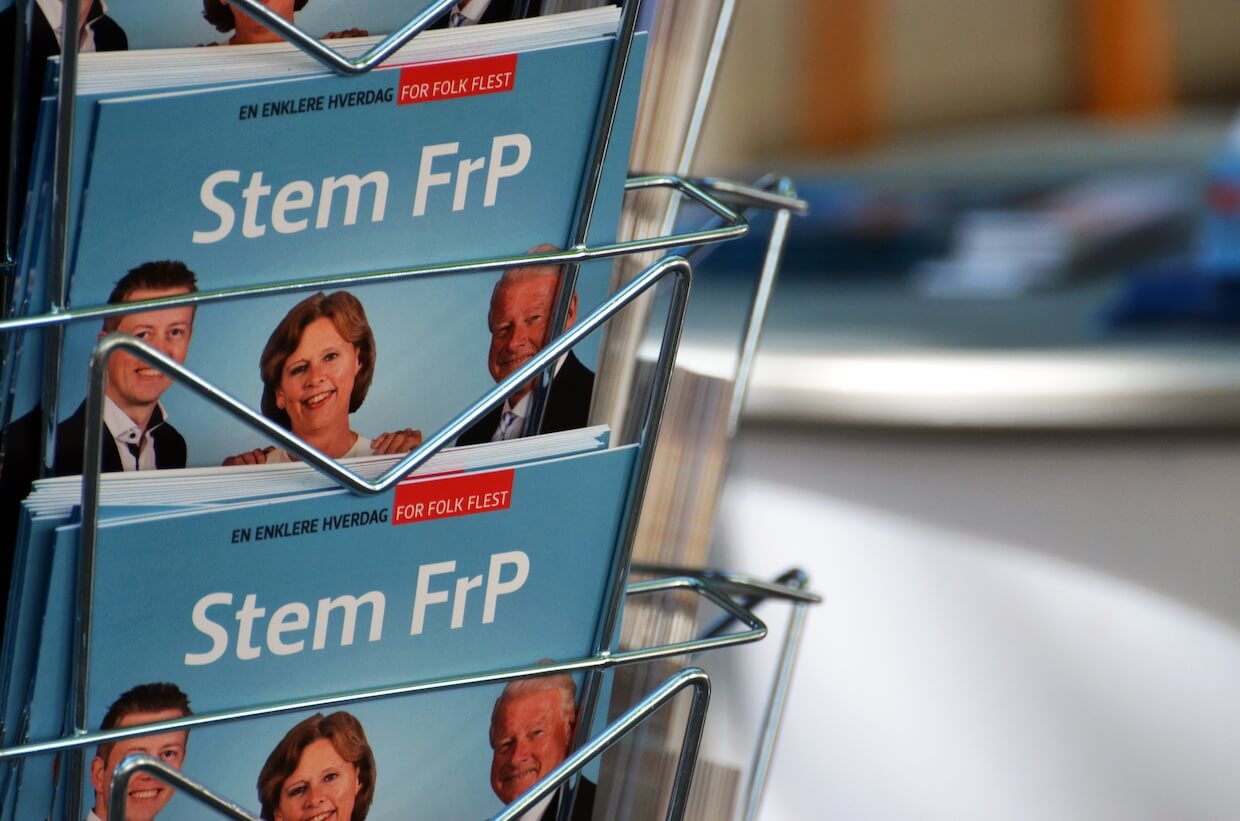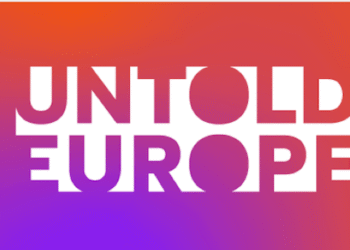In Norway’s September 8, 2025, general election, Prime Minister Jonas Gahr Støre’s Labour Party narrowly held on to power — but the real story was the historic surge of the populist Progress Party (FrP), which doubled its vote share to 24% and became the country’s second-largest party. In an interview with ECPS, Dr. Lise Bjånesøy (University of Bergen) explains how FrP converted economic grievances into populist momentum, capitalizing on anger over wealth taxes, cost-of-living pressures, and distrust of “wasteful elites.” FrP also mobilized younger men through social media, a trend Dr. Bjånesøy calls a key driver of Norway’s new political divides.
Interview by Selcuk Gultasli
In the wake of Norway’s September 8, 2025, general election, the country’s political landscape has been reshaped by growing polarization and the unexpected strength of the populist radical right. While Prime Minister Jonas Gahr Støre’s Labour Party narrowly secured another four years in power with 87 out of 169 seats, the populist right-wing Progress Party (FrP) achieved a historic breakthrough, doubling its vote share to 24% and becoming the second-largest party. This surge signals deep currents of economic dissatisfaction and changing voter dynamics, especially among younger men.
In an exclusive interview with the European Center for Populism Studies (ECPS), Dr. Lise Bjånesøy, Postdoctoral Fellow at the Department of Government, University of Bergen, offers insights into how FrP transformed economic frustration into populist momentum. “Economic issues, such as wealth tax and the cost of living, have been central in this election,” explains Dr. Bjånesøy. “FrP has strongly profiled itself against wasting taxpayers’ money, attracting voters dissatisfied with Labour and consolidating support among those frustrated with rising living costs.”
FrP’s success, however, goes beyond economics. Dr. Bjånesøy highlights the party’s strategic mobilization of young voters, particularly young men, driven largely by social media dynamics. “For young men who get their news from social media, there’s a 28% likelihood of voting FrP, compared to just 14% among those who don’t. Social media plays an important role in mobilizing this demographic.”
Despite this populist surge, Norway remains a centre-left outlier in the Nordic region, diverging from Sweden and Finland, where right-wing governments dominate. Dr. Bjånesøy attributes this partly to narrow electoral thresholds and coalition dynamics, as well as Labor’s recovery under Jens Stoltenberg’s return as finance minister, dubbed the “Stoltenback effect,” which boosted Labor’s popularity by 10 percentage points.
Still, she warns against underestimating FrP’s growing influence: “FrP has benefited from reduced stigma around supporting the party and has mobilized nearly all the voters who don’t dislike them. But their ability to expand further will depend on how effectively Labour manages governing alongside four smaller left-wing parties.”
Looking ahead, Dr. Bjånesøy underscores the urgent need for research on social media’s political impact, calling it a “key driver of generational divides” and shifting populist dynamics.
This interview unpacks the interplay between economic grievances, political polarization, and digital mobilization in shaping Norway’s electoral landscape — and what it reveals about the future of populism in Europe.
Here is the transcript of our interview with Dr. Lise Bjånesøy, lightly edited for clarity and readability.
Economic Grievances Fuel FrP’s Surge

Dr. Lise Bjånesøy, thank you so much for joining our interview series. Let me start right away with the first question: The general elections on Monday (September 8, 2025) saw Labour narrowly retain power while the populist radical right Progress Party (FrP) nearly doubled its vote share to 24%. From your research, what explains FrP’s electoral surge despite being historically the most disliked party in Norway?
Dr. Lise Bjånesøy: It’s a very good question. I think there are quite a few reasons why the Progress Party (FrP) has been doing so well in this election. First of all, it has been the loudest opposition party to the current government, which helps them attract voters dissatisfied with the Labour government as well as generally discontented voters.
Second, economic issues have been a very important part of this election. It’s been a big, salient topic, and the FrP has benefited from that focus. Another significant factor is that they have gained many voters from the Conservative Party. In fact, a lot of people who previously voted Conservative now support the Progress Party. At least that’s what we’ve seen in earlier data. We’ll have to wait, of course, for the post-election data collection, but when we conducted a large survey in June, we found that 50% of those who said they intended to vote for the Progress Party had previously supported the Conservatives.
Another reason is that they attract more young voters, particularly young men, and social media seems to play an important mobilizing role for this group.
Regarding the Progress Party’s reputation as a very disliked party — which it still is within the Norwegian political system — I think this suggests they may now have mobilized almost all the voters they can. In other words, they’ve consolidated support among those who don’t dislike them, but they remain a highly unpopular party overall.
Media analyses describe the rise of FrP as part of the “MAGA-fication” of Norwegian politics, particularly among young male voters. To what extent does FrP’s messaging reflect a broader Americanization of populist rhetoric, and how much is it rooted in domestic Norwegian grievances?
Dr. Lise Bjånesøy: That’s a good question. First of all, I think it’s very interesting how a Norwegian election campaign is perceived in other countries. I’ve not heard the word MAGA-fication in any Norwegian newspapers, and I don’t think we would use that term to describe what is going on in Norway. So, I don’t think we can take it that far as being a MAGA-fication. Although the FrP did very well in this election — historically well, indeed — and they are attracting young men in particular, I still don’t think I would use the word MAGA-fication. I think, as you say, the success of the Progress Party in this election can be explained by domestic Norwegian grievances rather than any Americanization of populist rhetoric.
There has been one incident that perhaps comes a little close to the Americanization of populist rhetoric, and that was just a few days before the election, or very close to election night. There was a televised political debate where the leader of the Progress Party, Sylvi Listhaug, blamed the leader of the AUF, the youth wing of the Labour Party, for being a notorious liar, and she repeated over and over again that he is a liar, ‘you’re lying’. This was based on a relatively normal political statement, and yet she labelled him a liar. The Prime Minister, Jonas Gahr Støre, who was also part of that debate, responded by saying, essentially, "Okay, so you want to become Prime Minister, but you can’t talk like this." That, he implied, would represent a new turn for Norway.
So, I think that might be one of those rare events that could be described as an Americanization of populist rhetoric. But other than that, we haven’t really seen this pattern; it hasn’t been a major part of the election campaign, at least in my view.

FrP Capitalizes on Economic Anger While Labour Leans on Stoltenberg Boost
The campaign was dominated by debates on the cost of living, wealth taxes, the oil fund’s investment in Israel, and relations with Donald Trump. How did FrP successfully own these issues and deploy populist frames contrasting “the people” with “corrupt elites” or “globalist priorities”?
Dr. Lise Bjånesøy: The economic issues you mentioned, such as wealth tax and cost of living, are very important political issues for the Progress Party. They attract voters who are against the wealth tax, for instance. The high salience of this issue can probably help explain some of the gains and some of the success of the Progress Party in this election. Another example is that they have strongly profiled themselves as being against wasting taxpayers’ money. On the cost of living, they argue that the current government spends far too much of the taxpayers’ money and simply wastes it away. These have been two key issues for the Progress Party and their voters.
However, issues such as foreign policy and relations with Donald Trump are among the reasons why Labour did so well in this election. It never became quite clear during the campaign whether Listhaug would be a candidate for Prime Minister. She never explicitly said she wanted to be, but she repeated that it was natural for the party with the highest share of votes to take the Prime Minister position. So, it was never a clear yes or no. This created debate about whether she would do a good job as a potential Prime Minister, especially when it came to foreign policy and representing Norwegian interests in relation to Donald Trump, for example. So, I think some of these issues were very good for the Progress Party, but issues like foreign policy worked in favour of Labour and the current government.
Labour’s rebound has been attributed in part to the “Stoltenback effect,” boosting Labour’s popularity by 10 percentage points following Jens Stoltenberg’s return as finance minister. Do you see this as evidence of leadership personalization countering populist momentum, or does it simply mask deeper structural shifts favouring PRR parties?
Dr. Lise Bjånesøy: There are several reasons that can explain this boosted popularity of the Labour Party. One of the reasons is the one you mentioned — the Stoltenback effect — as we got Jan Stoltenberg back as finance minister. But it’s also important to mention that it was the current Prime Minister, Jonas Gahr Støre, who brought Stoltenberg back. So, it was also a boost in popularity for him, showing good leadership skills by bringing Stoltenberg back.
Another important issue is that the agrarian Centre Party, which had previously been in a coalition with the Labour Party, left the government coalition. So now, the Labour Party holds government power alone. It was a minority government, and I think that was very good for Labour.
A third explanation is foreign policy and Trump, as we just talked about. We want competent and highly experienced politicians to navigate this sort of uncertain political world that we are living in.
Finally, I think it’s quite exceptional how the Labour Party — and the current government — was so unpopular for a long time because the economy was performing poorly, yet they still managed to retain power. It makes this quite an exceptional election. A fourth contributing factor is that while the economy had been doing really badly, it is now performing much better. So, they have managed to turn the economy around to a better situation for people.
Norway Balances Populist Surge with Centre-Left Resilience
Despite FrP’s strong gains, Norway remains a centre-left outlier compared to Sweden and Finland. Based on your work on political tolerance, why has Norway diverged from this broader Nordic trend, and what factors have enabled it to resist a full populist breakthrough despite growing polarization?
Dr. Lise Bjånesøy: It’s important to emphasize that the results of this current election would have looked different if the Green Party, which is part of the left-wing bloc, had not passed the electoral threshold, and if the Liberal Party, which is part of the right-wing bloc, had passed it. In that case, this election could still have been a win for the right-wing bloc. But it ultimately ended up being a win for the left-wing bloc.
One key reason for this outcome is that the Green Party, for the first time, passed the electoral threshold and received what’s called utjevningsmandat — additional seats in the Storting (Norwegian parliament). However, it’s also important to emphasize that the Labour Party, which is now most likely continuing as a minority government, will have to navigate the next four years with four smaller parties. This could prove very challenging and, in fact, represents something of a dream opportunity for the Progress Party, which will likely benefit from Labour having to cooperate with these four much smaller left-wing parties.
Considering how well the Progress Party performed in this election, I don’t think Norway is an outlier, because we see two dynamics unfolding simultaneously. On one hand, there is a clear right-wing wave and a significant boost for the Progress Party; on the other, there is continued support for the current government. These trends coexist, but in the end, the results largely come down to the margins of which parties managed to pass — or failed to pass — the electoral threshold.
In your dissertation, you argue that FrP is both politically tolerated and highly negatively evaluated. How do you reconcile this paradox, particularly in the light of FrP’s breakthrough in the 2025 election?
Dr. Lise Bjånesøy: I think real tolerance is to allow democratic rights and privileges to those you dislike or disagree with. In that sense, it’s perhaps not a paradox; the Progress Party is still disliked, but we still see high tolerance of the party. However, based on these high levels of dislike for the FrP, the Progress Party might have reached its electoral high at this point. Maybe there are no more voters to mobilize. That said, this can change in the next election. We have seen that the levels of dislike for the Progress Party fluctuate. If I remember correctly, the highest levels were above 60%, and now about 55% of voters dislike the party. So, slightly fewer voters now dislike the party than before. A few more also tend to like it, but this can change.
Still, because of these very high levels of dislike towards the Progress Party, it can be hard for them to mobilize even more voters than they already have. Another important point when discussing the dislike of the Progress Party is that they have to collaborate. If the right-wing bloc had won the election, they would have had to work with parties whose voters dislike them. For the Liberal Party, for instance, many of its voters dislike the Progress Party, which makes collaboration difficult, or at least quite challenging, for a potential governing bloc. For some voters, it would be hard to accept cooperation with the Progress Party. Especially if we go back to the example where Listhaug called the youth wing leader of the Labour Party a liar, a notorious liar — that kind of rhetoric is very difficult for the Liberal Party to accept.
Less Stigma, Digital Mobilization, and a Generational Shift

Your findings show that party institutionalization influences public tolerance of the populist radical right. Given FrP’s long-standing presence in Norway’s political system, does this institutional legitimacy insulate it from the broader backlash against far-right parties elsewhere in Europe?
Dr. Lise Bjånesøy: This might actually be another reason why the Progress Party did very well in this election. There has been less stigma connected towards voting FrP in this election compared to elections before. It seems like it’s more acceptable to say that you are a Progress Party voter than it has been before. This is not based on data — this is just my hunch — and we haven’t seen this in the data yet, but my hunch says that there is actually less stigma directed towards being a Progress Party voter than there has been before.
One reason might be that the party has moderated itself, particularly after the past government experience. The government experience that they have had might also contribute to less stigma towards them. However, voters still didn’t want Sylvi Listhaug as Prime Minister. That was part of the political debate in this election — whether she was going to be a Prime Minister or not — and most voters didn’t want her as Prime Minister.
So, I don’t think that any political parties are immune to backlash. But I think that the Progress Party benefits a lot from the current political situation, when the Støre government will have to cooperate with these four smaller parties on the left. I think the next election in four years will be extremely exciting. It will be very interesting to see how well the Progress Party does then. Maybe they will get an even better boost of votes — we’ll have to see.
With FrP performing especially well among younger male voters, do you see signs of a generational realignment in Norwegian politics, or is this a temporary reaction to specific economic and identity-based issues?
Dr. Lise Bjånesøy: In this election, we have seen that young men turn to FrP, while young women turn to the left. That’s a sign of increased polarization among young people — men go one way, and young women go the other. One of the things we’ve seen in our data — we’ve analysed data from the Norwegian Citizen Panel, where we have around 10,000 participants — is that we can look in more detail at how young men and young women vote.
What we’ve found using those data is that both young women and young men actually have an increased likelihood of voting for the Progress Party if they get their news from social media. For young men, there is a 28% likelihood of voting FrP if they get their news from social media. And if you are a young man who does not get your news from social media, there’s only a 14% chance that you will vote for the Progress Party. It’s a huge boost in the likelihood of voting FrP if you are a young man and get your news from social media.
We find the same pattern among young women as well, but it’s a much weaker relationship, so it’s particularly strong among young men. We also find that young men who get their news from social media tend to place themselves further to the right, and they are more dissatisfied with the economy. So, in that case, we can say they’re not being “tricked” into voting for the Progress Party — they genuinely agree with them.
Of course, it might be that those who place themselves further to the right and want to vote for the Progress Party are also those who tend to get their news from social media. But still, I think there’s something going on with social media that is an important explanation for what’s happening among young men.
I also don’t think this is just a temporary shift. But I think we need to learn more about what’s going on, particularly in this case, and also study more closely what’s happening on social media. We’ll just have to wait — we need a lot more research on this particular topic — but there are definitely some very interesting dynamics unfolding among the young.
Positive Views on Immigration Hold
In your 2019 article, you found that public attitudes toward asylum seekers shifted after the 2015 refugee crisis. Has the 2025 campaign, particularly debates on Gaza and Ukraine, triggered similar shifts in threat perceptions and migrant-related framing?
Dr. Lise Bjånesøy: Immigration issues were not a big part of this election campaign. So, in that case, there was no particular reason to expect any shift in public attitudes based on the campaign itself. But I think it’s interesting how we still remain quite positive towards immigration after receiving a large number of refugees from Ukraine, especially. This means that we did not see the same shift in public attitudes as we did during the 2015 refugee crisis when Norway also received a significant number of refugees.
Looking at trends and opinion data collected in the Norwegian Citizen Panel, we see that 51% of respondents think that immigration is an advantage, which is actually exactly the same level as in 2014. Back then, 51% also said that they viewed immigration positively. So, while the trend fluctuates somewhat over time, at this point, it stands at the same level as when we first started measuring it in 2014.
However, on some other questions we examine, more people today say that they think it should be more difficult to get asylum. We also see an increase in people who believe that the conditions for integrating refugees in Norway are bad, or at least not very good. So, there is some movement and some shifts in attitudes towards immigration and asylum seekers, but I haven’t seen anything specific related to this current election.
Social Media’s Role Needs Deeper Investigation

Your research suggests media framing can normalize exclusionary populist narratives. To what extent did the Norwegian media in 2025 amplify FrP’s populist discourse, and does this signal a shift toward mainstreaming radical right rhetoric?
Dr. Lise Bjånesøy: That’s a whole research question in itself. Based on what I’ve seen, we had quite a fair election campaign, where the various political parties participated in debates and were given the same opportunities on the same media platforms to debate. But we have been very interested, both in research and in the media, in what’s going on with young men in this election. However, I haven’t seen the same level of interest in young women. So, we have some shifts in the media that affect our focus, I guess. Maybe I would like to see more attention paid to what’s going on with young women as well.
FrP has gained a lot of media attention, particularly because they were doing very well in the polls, so it was natural to be interested in that, but also because they were performing strongly among young men. So, we’ve seen this increase in media attention, but I do think that, if anything, we should pay even more attention to what’s happening on social media. And that would be my hunch, based on your question.
And lastly, looking ahead, what research agenda do you see as most urgent for understanding the evolving relationship between populist radical right parties, public opinion, and democratic resilience in Norway and across Europe?
Dr. Lise Bjånesøy: I’ve probably also given away what I think is one of the most important areas to focus on now. One of the key research agendas going forward is to learn more about what is happening on social media — how we are affected by it, or not affected by it, and how our experiences on these platforms differ. The algorithms give us more of the content that we already like, and we need to understand what effects this has on political participation, both in Norway and across Europe. I believe this is a very important research agenda, as we currently know too little about the effects of social media on politics.


